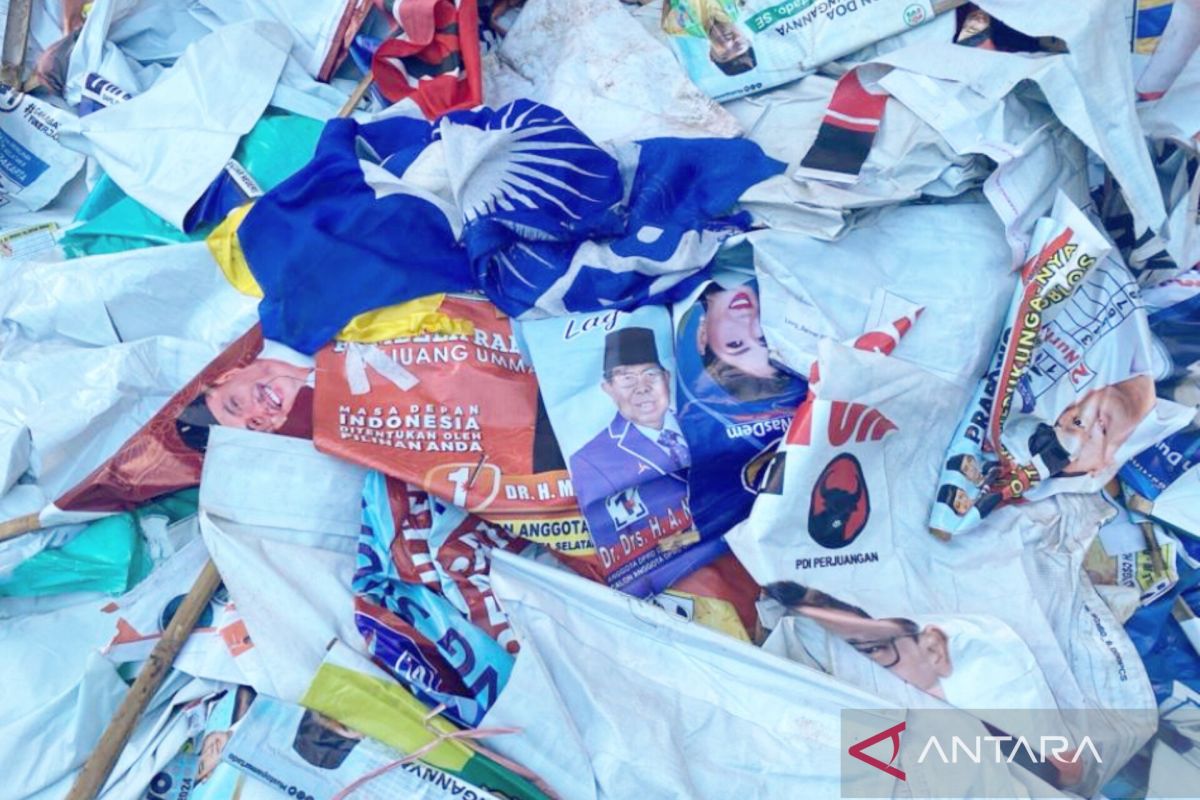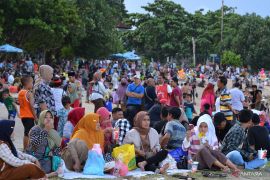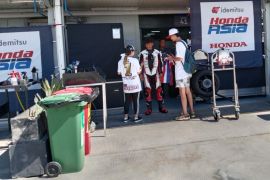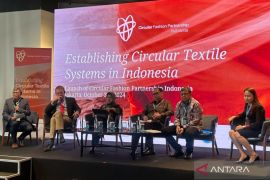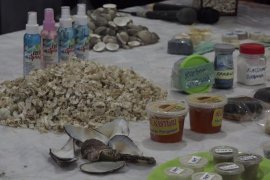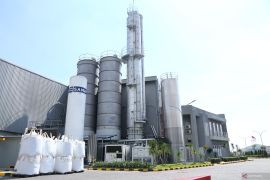Indonesians welcomed the much-anticipated quinquennial fiesta of democracy enthusiastically, as evidenced by their demonstrations of support for their preferred presidential-vice presidential pairs, legislators, and regional representatives in this year's general elections.
To show their support, people and political parties installed many types of campaign props, such as banners, posters, and billboards, almost everywhere, including public facilities and infrastructure.
During the campaign period from November 28, 2023, to February 10, 2024, campaign props were rather ubiquitous, and could be seen strewn over flyovers, pedestrian bridges, and even road dividers.
The campaign period and Election Day (February 14) have now passed. The question that remains is: Will stakeholders be able to properly manage campaign props now that they are no longer needed?
In the Indonesian capital Jakarta, the mounting waste of campaign props will likely add to the volume of trash flowing from the city to Bantargebang Landfill in Bekasi, West Java. On a daily basis, Jakarta sends 7,500 tons of waste to the landfill.
A local creative group called Gudskul Rekayasa dan Dicoba-coba (GudRnD) has devised a solution to the problem — turning campaign props into goods with added value.
From their base in Jagakarsa, South Jakarta, eight members of the group have been working hand in hand to prevent campaign props from ending up as waste by recycling them into multiplex banners and products such as chairs, tables, tiles, and board games worth tens of thousands to millions of rupiah.
Muhammad Aldino, 28, a member of GudRnD, wants campaign props to be turned into products with economic and artistic value. He believes that campaign props are meant to be recycled into more meaningful goods, instead of being abandoned as waste.
With one chopping machine and two pressing machines at his disposal, Aldino has been successfully recycling campaign props, feeding his love for putting waste to use.
For him, participating in taking down campaign props during the election silence period from February 11–13 was an unforgettable experience.
"On the first day of the silence period, we, together with locals, managed to secure a total of 500 kilograms of billboards and other campaign props installed along one kilometer of road at dawn," Aldino told ANTARA in Jakarta.
He said that he took the initiative to help the Jakarta Public Order Security Agency (Satpol PP), General Election Supervisory Agency (Bawaslu), and public infrastructure and facilities management officers remove campaign props installed in inaccessible areas.
He informed that he received 3 tons and 2.5 tons of recyclable campaign props from Cipedak and Pancoran Mas areas, respectively.
The creative youth informed that the recycling process involved sorting different types of campaign props, and then cleaning, chopping, and pressing them. It takes 90 small-sized banners, with a total weight of 1.3 kilograms, to produce one multiplex banner in three hours. GudRnD currently has the capacity to create as many as 16 multiplex banners out of campaign props waste every day.
Aldino expressed the hope that the Jakarta provincial government and relevant stakeholders would jointly take responsibility to address the issue of "political waste" and prevent it from piling up in Jakarta.
He also urged election contestants to invite local residents to collect campaign props for recycling so that they can derive economic benefits from the fiesta of democracy.
Government measures
The provincial government of Jakarta has been striving to transport waste campaign props to a waste processing facility in the TB Simatupang area to be recycled into goods that have economic value.
Deputy head of the Jakarta Environment Office, Sarjoko, said that his side has been receiving a lot of wood and bamboo used for displaying campaign props.
According to him, the waste processing facility in TB Simatupang can turn wood and bamboo waste into compost. Meanwhile, banners and billboards made from plastic can be turned into non-organic fuel and quality raw materials, he informed.
"We can utilize campaign props made from textile to fuel the Bantargebang Waste-to-Energy Plant. However, they should be initially chopped in the facility in TB Simatupang," Sarjoko said.
During the election silence period, the Jakarta Environment Office received a total of 13,690 kilograms of waste campaign props for recycling.
During the 2024 General Elections, Indonesians cast their votes to elect members of the House of Representatives (DPR); provincial, municipal, and district legislative councils (DPRD); the Regional Representative Council (DP); as well as the president and vice president.
Three candidate pairs are vying for the country's leadership — Anies Baswedan-Muhaimin Iskandar, Prabowo Subianto-Gibran Rakabuming Raka, and Ganjar Pranowo-Mahfud MD.
The nation is currently waiting for the General Elections Commission (KPU) to complete the vote-counting process and reveal the final results.
In Jakarta, a total of 8,252,892 residents were registered in the fixed voter list. During the elections, 30,766 polling stations were set up in 6 administrative cities/districts, 44 sub-districts, and 267 villages in the Indonesian capital.
The generation of a large volume of campaign prop waste during the elections can be attributed to the fact that the legislative election was participated by a plethora of contestants who installed banners, posters, and billboards in public spaces. As a result, Indonesia is now facing a mounting pile of used campaign props that need to be managed properly.
Fortunately, the country is not lacking in creative talents with the capability of turning such waste into more valuable goods that are expected to not only generate economic benefits, but also help keep the volume of trash in check.
Related news: ASDP installs reverse vending machines to cut marine plastic waste
Related news: Plastic, paper waste hold vast potential for recycling industry: gov't
To show their support, people and political parties installed many types of campaign props, such as banners, posters, and billboards, almost everywhere, including public facilities and infrastructure.
During the campaign period from November 28, 2023, to February 10, 2024, campaign props were rather ubiquitous, and could be seen strewn over flyovers, pedestrian bridges, and even road dividers.
The campaign period and Election Day (February 14) have now passed. The question that remains is: Will stakeholders be able to properly manage campaign props now that they are no longer needed?
In the Indonesian capital Jakarta, the mounting waste of campaign props will likely add to the volume of trash flowing from the city to Bantargebang Landfill in Bekasi, West Java. On a daily basis, Jakarta sends 7,500 tons of waste to the landfill.
A local creative group called Gudskul Rekayasa dan Dicoba-coba (GudRnD) has devised a solution to the problem — turning campaign props into goods with added value.
From their base in Jagakarsa, South Jakarta, eight members of the group have been working hand in hand to prevent campaign props from ending up as waste by recycling them into multiplex banners and products such as chairs, tables, tiles, and board games worth tens of thousands to millions of rupiah.
Muhammad Aldino, 28, a member of GudRnD, wants campaign props to be turned into products with economic and artistic value. He believes that campaign props are meant to be recycled into more meaningful goods, instead of being abandoned as waste.
With one chopping machine and two pressing machines at his disposal, Aldino has been successfully recycling campaign props, feeding his love for putting waste to use.
For him, participating in taking down campaign props during the election silence period from February 11–13 was an unforgettable experience.
"On the first day of the silence period, we, together with locals, managed to secure a total of 500 kilograms of billboards and other campaign props installed along one kilometer of road at dawn," Aldino told ANTARA in Jakarta.
He said that he took the initiative to help the Jakarta Public Order Security Agency (Satpol PP), General Election Supervisory Agency (Bawaslu), and public infrastructure and facilities management officers remove campaign props installed in inaccessible areas.
He informed that he received 3 tons and 2.5 tons of recyclable campaign props from Cipedak and Pancoran Mas areas, respectively.
The creative youth informed that the recycling process involved sorting different types of campaign props, and then cleaning, chopping, and pressing them. It takes 90 small-sized banners, with a total weight of 1.3 kilograms, to produce one multiplex banner in three hours. GudRnD currently has the capacity to create as many as 16 multiplex banners out of campaign props waste every day.
Aldino expressed the hope that the Jakarta provincial government and relevant stakeholders would jointly take responsibility to address the issue of "political waste" and prevent it from piling up in Jakarta.
He also urged election contestants to invite local residents to collect campaign props for recycling so that they can derive economic benefits from the fiesta of democracy.
Government measures
The provincial government of Jakarta has been striving to transport waste campaign props to a waste processing facility in the TB Simatupang area to be recycled into goods that have economic value.
Deputy head of the Jakarta Environment Office, Sarjoko, said that his side has been receiving a lot of wood and bamboo used for displaying campaign props.
According to him, the waste processing facility in TB Simatupang can turn wood and bamboo waste into compost. Meanwhile, banners and billboards made from plastic can be turned into non-organic fuel and quality raw materials, he informed.
"We can utilize campaign props made from textile to fuel the Bantargebang Waste-to-Energy Plant. However, they should be initially chopped in the facility in TB Simatupang," Sarjoko said.
During the election silence period, the Jakarta Environment Office received a total of 13,690 kilograms of waste campaign props for recycling.
During the 2024 General Elections, Indonesians cast their votes to elect members of the House of Representatives (DPR); provincial, municipal, and district legislative councils (DPRD); the Regional Representative Council (DP); as well as the president and vice president.
Three candidate pairs are vying for the country's leadership — Anies Baswedan-Muhaimin Iskandar, Prabowo Subianto-Gibran Rakabuming Raka, and Ganjar Pranowo-Mahfud MD.
The nation is currently waiting for the General Elections Commission (KPU) to complete the vote-counting process and reveal the final results.
In Jakarta, a total of 8,252,892 residents were registered in the fixed voter list. During the elections, 30,766 polling stations were set up in 6 administrative cities/districts, 44 sub-districts, and 267 villages in the Indonesian capital.
The generation of a large volume of campaign prop waste during the elections can be attributed to the fact that the legislative election was participated by a plethora of contestants who installed banners, posters, and billboards in public spaces. As a result, Indonesia is now facing a mounting pile of used campaign props that need to be managed properly.
Fortunately, the country is not lacking in creative talents with the capability of turning such waste into more valuable goods that are expected to not only generate economic benefits, but also help keep the volume of trash in check.
Related news: ASDP installs reverse vending machines to cut marine plastic waste
Related news: Plastic, paper waste hold vast potential for recycling industry: gov't
Editor: Rahmad Nasution
Copyright © ANTARA 2024
